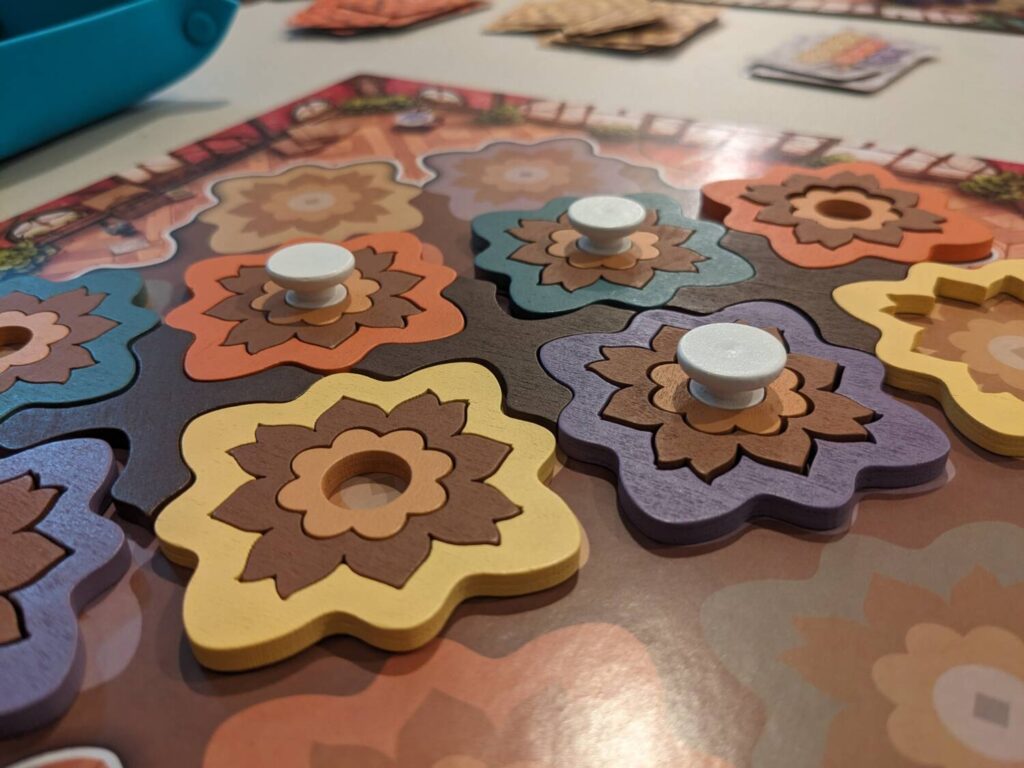Disclosure: Meeple Mountain received a free copy of this product in exchange for an honest, unbiased review. This review is not intended to be an endorsement.
When I picked up a review copy of Intarsia (2024, Pegasus Spiele) at Gen Con 2024, it was one of my most anticipated games from the show. Sure, no one was really buzzing about it right after the show, but not everything can be Rock Hard 1977, right?
And I was excited for the right reasons: Intarsia was designed by Michael Kiesling, the man who has given us so many great titles over the last 20 years, such as Heaven & Ale, Wandering Towers, and maybe the most popular abstract of the last ten years, Azul (depending on the month, the most popular of the 900+ games on Board Game Arena).
In other words, Kiesling knows a thing or two about games. So, a couple weeks after I got back from Gen Con, I got Intarsia to the table, and it was…OK. Good, even. Maybe not wow, but certainly interesting. That first play was with two people, so I waited until I could try Intarsia at its full player count of four, and another week or two later, I achieved that goal.
It was still good, but I kept waiting for wow moments that never materialized. Intarsia was certainly better at four players, so that was promising, but I found myself making a lot of those “hrmph!” sounds when things were interesting but not necessarily thrilling.
Intarsia is a fantastic physical package and a game that can be taught in five minutes even to a casual gamer. Turns are quick, managing a hand of building cards makes intuitive sense, and the game’s building reward system allows for a player to set up future moves in a fun way.
I just wanted Intarsia to knock my socks off. For better and for worse, my socks are still on.

Frame, Midsection, Core, Table
Intarsia is a 2-4 player pattern building game that plays in about an hour. The game is set at the Café de Paris, where players take on the role of architects tasked with rebuilding the parquet floor by providing a design that must be deemed best by Café ownership. The winner will, according to the manual, “secure the contract for the intricate inlay work.”
Yes, friends…the game’s theme asks players to work the hardest to secure a contract for intricate inlay work. If that isn’t a sign that Intarsia is one of the driest, most mechanical gaming experiences you’re going to have this year, I’m not sure what is!
In each of the game’s three rounds, players will use a hand of cards (in the four colors representing frames, plus a fifth card type that serves as a wild card) to pay for each portion of the “floor board” that each player uses to build out their designs. The floor board’s layout is broken into colors, with some spaces used to build frames and some used to build connectors, which bridge the gaps between frames.
Turns are snappy. 1-4 cards are spent to build a portion of a frame or to build a connector. Depending on the cost of the piece being built, a player is given a reward of additional building cards that can be used on later turns. The frames are the outer edge of a four-piece “wood element” that has to be built from outer edge to innermost piece…so, if a player wants to ultimately build the final piece, a table, into their wood element, they’ll have to take four different turns to get there because a frame is built first, then a midsection, then a core, then the table. (The rulebook takes great pains to remind players of this, in part because the Euro player in all of us is always trying to find a way to build 2-3 pieces in a single action. Not possible with Intarsia!)

Each piece is paid for using cards matching the color of the frame, so to build a midsection for a purple frame, a player must spend two purple cards (or, less efficiently, two non-purple cards as a purple card). As a reward, that player would get one non-purple card added to their hand to build something on a future turn. Building tables and/or connectors yields a bigger reward: a player moves a marker around the inner edge of the scoring track that shows a host of differing rewards to take three cards based on where the marker can be moved on that turn.
Any time a player builds something, they must check the tool board to see if they achieved a public milestone across one of six different columns. If so, they score 1-3 points based on the achievement, then score more points if their newest milestone has a symbol matching the symbols on any previously-completed reward tiles in their possession. In our plays, we found it hard to specialize in a column—every reward in a column is from a different frame color category, and some are much harder to complete than others. But, it was often a nice boost to score for multiple tiles on the same turn, so if the stars aligned, it was great to score a few extra victory points.
If a player can’t play on their turn, they must pass…and, when all players have passed, the round is over. Connectors are scored at the end of each round before players start a new round by drafting a setup card that provides 10 building cards to use for the upcoming round.

It’s All Fine
Intarsia’s biggest crime is that it is a solidly designed, unspectacular play-producing abstract. You and I could both do a lot worse, but given the designer pedigree, you might come into this rightly expecting much better.
Everything works, and occasionally, something shines. Games always produced close results, particularly in my only two-player game where it felt like my opponent and I just buzzed through the game by quietly deciding to focus on two of the game’s four colors each, claiming as many goals in those colors as we could, and ending the game with a score that was two points apart from each other.
I’m not sure I did something particularly special to win that two-player game, and a look at our tool tiles told me that we basically did the same thing all game long Maybe at one point I was able to score a larger pool of matching tool tile types on a turn. While that victory didn’t feel earned, I’m not sure what other way the game had to tell us that I was playing a better game than he was.
A bit like a recent deck-builder I tried, Avant Carde, Intarsia feels like a game that was playing me as much as I was playing it. If I started a round with my 10 cards and seven of them were purple and orange, I spent the round going hard on those two colors of my board to build more pieces and take my reward cards to build the opposite color.
If I got stuck and needed to build a connector to get me more purple and orange sections of my floor board, I used my other color cards to help achieve that. It didn’t feel like Intarsia was ever going to turn into a game where one could pivot to a completely different strategy and still produce a winning result.

If I had to directly compare Intarsia to Azul, I would tell a shopper that Intarsia is easier to teach than Azul and produces closer games than Azul does. I have seen shockingly disparate final scores in Azul, even amongst newer players when they are surrounded by other rookies. The best Azul player I know would wipe the floor with most Azul players, given her success playing in BGA tournaments online. With Intarsia, I’m not sure that is really possible, especially if you can convince new players to never do the badly inefficient two-for-one card trade mentioned earlier to build wood elements.
Intarsia’s biggest win is its production. Wow, this is a great-looking game, with a handsome organizer in the box to keep all the bits in place. It’s a joy to place that final table in a wood element, and it’s clear that the game’s final scoring rewards a player who goes hard to complete more four-piece sets than their competitors. Intarsia—like Azul, which has my favorite chunky tile pieces in gaming–certainly has the tactile joy part down pat.
Intarsia’s depth comes from a flipped floor board, with a B side that is a little harder to build out and score around because of the way the B side’s connector pieces work to affect final scoring. Beyond that, I don’t think Intarsia is going to look drastically different from game to game, which might be another strength—in a world where many gamers play a game only once or twice before moving on, Intarsia is an interesting game for its first few plays and is super-easy to table.
Intarsia would certainly be a game I valued more if it had come from another designer. That’s the problem with expectations, isn’t it? As is, give Intarsia a look if you want to decipher a fun puzzle in a digestible package that can be played by gamers of all shades.












Add Comment